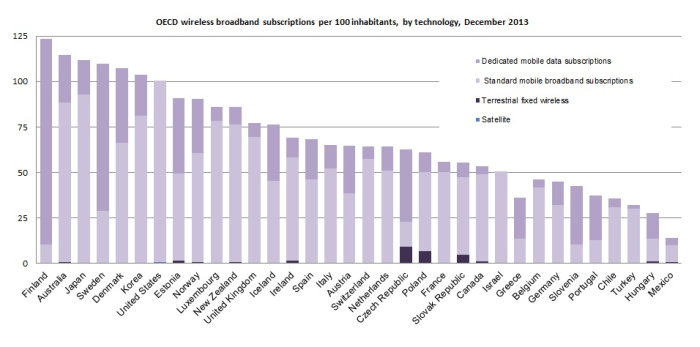This article is more than 1 year old
The seven nations where SIM CARDS outnumber PEOPLE
PLUS: You'll never guess the nations where broadband's IN REVERSE!
The Organisation for Economic Co-Operation and Development's (OECD's) latest broadband statistics update reports that about 72 per cent of the group's residents now have access to broadband.
Startlingly, the data also reports that seven nations - Finland, Australia, Japan, Sweden, Denmark, Korea and the United States – now have more mobile data accounts than people.
That seeming anomaly is possible because the OECD counts “standard” and “dedicated” mobile broadband subscriptions separately. A smartphone with a data plan and a wireless broadband USB dongle therefore each count as one subscription. Even with that method offering clear potential for inflation, Finland's near-125-per-cent penetration is impressive. Among heavy Reg-reading nations, the USA just falls over the 100 per cent mark, Australia is a few points behind Finland, the UK has just passed 75 per cent and Canada languishes in the low fifties.

Finland: OECD wireless broadband capital. Embiggenif you dare.
Across the 34-nation bloc, the OECD says there are now 339, 001,480 fixed-line broadband subscriptions of all sorts. DSL dominates in most nations, save a few like the USA where cable dominates.Among the 909,677,153 wireless broadband connections, “standard” mobile connections lead by the length of the straight almost everywhere.
The data also shows that broadband still has a way to go before being ubiquitous, as 72.4 of OECD residents now have access to a connection. More than one in four does not.
The good news is that service availability is on the rise everywhere bar Italy and Luxembourg, which managed a 0.2 per cent and 0.4 per cent decline in services. Elsewhere, subscriber numbers are up between one and three per cent.
The report finds that DSL remains the dominant fixed line broadband technology, with 51.5 per cent of subscriptions, but that fibre is now at 16.7 per cent and growing quickly.
The OECD gathers data from its member nations. This lot covers calendar year 2013. The organisation keeps lots of historical data about matters broadband here. ®
